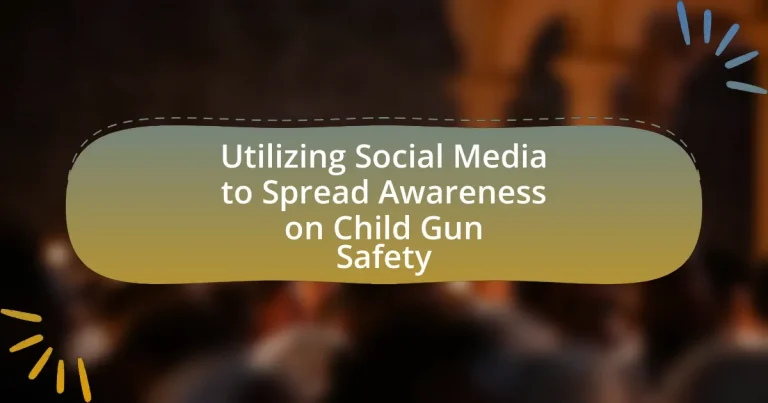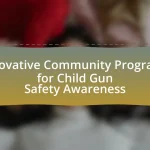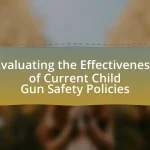The article focuses on the critical role of social media in raising awareness about child gun safety. It outlines how various platforms can be utilized for educational campaigns, emphasizing the importance of safe gun storage and teaching children about firearm dangers. Key strategies discussed include the use of engaging visuals, targeted messaging, and collaboration with influencers to enhance outreach. The article also highlights the significance of addressing misinformation and fostering community engagement through user-generated content and effective hashtags, ultimately aiming to reduce accidental shootings involving children.
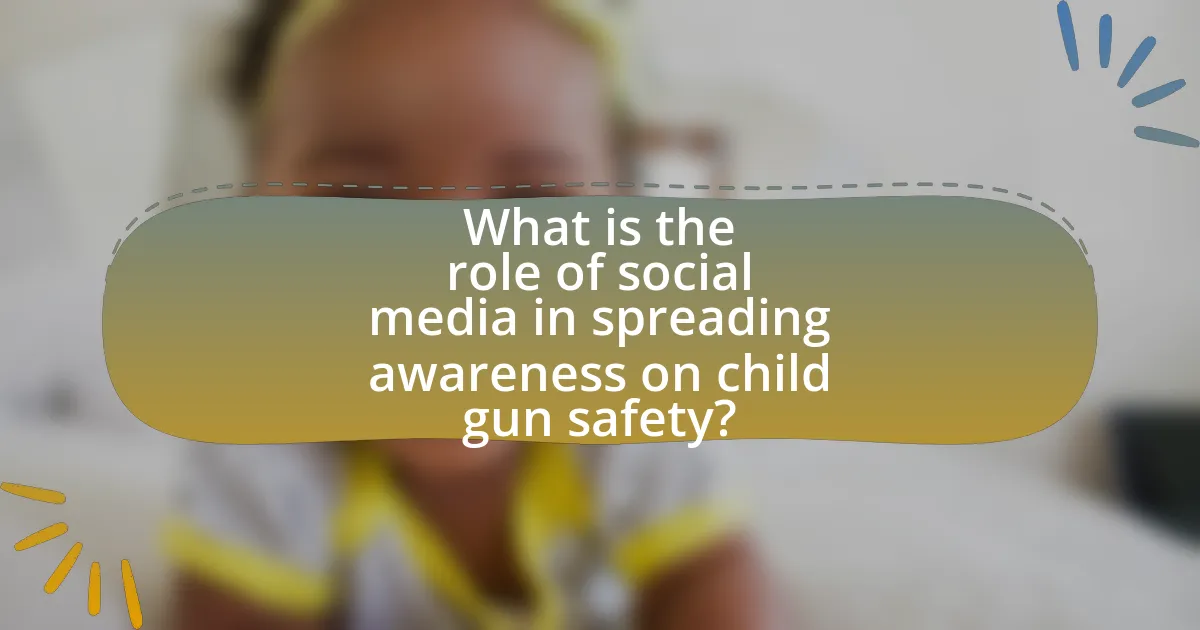
What is the role of social media in spreading awareness on child gun safety?
Social media plays a crucial role in spreading awareness on child gun safety by providing a platform for education, advocacy, and community engagement. Through targeted campaigns, organizations can share vital information about safe gun storage practices and the importance of teaching children about gun safety. For instance, the American Academy of Pediatrics emphasizes that social media can effectively reach parents and caregivers, increasing the likelihood of adopting safety measures. Additionally, statistics show that social media campaigns can significantly enhance public discourse, leading to increased awareness and proactive measures against accidental shootings involving children.
How can social media platforms be utilized for child gun safety awareness?
Social media platforms can be utilized for child gun safety awareness by disseminating educational content, engaging communities, and promoting safety campaigns. These platforms allow organizations and advocates to share informative posts, videos, and graphics that highlight the importance of gun safety practices for children. For instance, the National Shooting Sports Foundation has effectively used social media to promote their “Project ChildSafe” initiative, which provides resources and information on safe firearm storage. Additionally, interactive features such as polls, quizzes, and live discussions can foster community engagement and encourage parents to share their experiences and tips. Statistics show that 4.6 million children live in homes with loaded and unlocked guns, emphasizing the need for effective awareness campaigns on these platforms to reduce risks and promote safe practices.
What types of content are most effective for promoting child gun safety on social media?
Visual content, such as infographics and videos, is most effective for promoting child gun safety on social media. Infographics can convey critical statistics and safety tips in a visually engaging manner, making complex information easily digestible. For instance, a study by the American Academy of Pediatrics found that visual aids significantly enhance retention of safety information among parents. Videos demonstrating safe storage practices or role-playing scenarios can also effectively engage viewers, as they provide relatable and actionable content. Furthermore, user-generated content, such as testimonials or stories from families affected by gun incidents, can foster community engagement and raise awareness through personal narratives.
How do different demographics engage with child gun safety content on social media?
Different demographics engage with child gun safety content on social media through varying levels of interaction, sharing, and discussion. Research indicates that parents, particularly mothers, are more likely to engage with such content by sharing articles and resources, reflecting their primary concern for child safety. In contrast, younger demographics, including teenagers, may engage through likes and comments, often focusing on peer discussions rather than sharing. Additionally, older adults tend to engage by seeking information and resources, often sharing content within community groups. A study by the Pew Research Center found that 70% of parents actively seek parenting advice on social media, highlighting the platform’s role in disseminating child safety information. This engagement varies significantly across age, gender, and parental status, influencing how effectively child gun safety messages are communicated and received.
Why is child gun safety awareness important in today’s society?
Child gun safety awareness is crucial in today’s society due to the increasing incidence of unintentional shootings involving children. Statistics indicate that in the United States, nearly 400 children die from gun-related incidents each year, highlighting the urgent need for education on safe firearm practices. By promoting awareness, families can learn essential safety measures, such as secure storage of firearms and teaching children to recognize the dangers of guns. This proactive approach can significantly reduce the risk of accidents and save lives, making child gun safety awareness a vital component of community health and safety initiatives.
What statistics highlight the need for increased awareness on child gun safety?
In the United States, approximately 4.6 million children live in homes with at least one loaded and unlocked firearm, highlighting a critical need for increased awareness on child gun safety. Furthermore, data from the Centers for Disease Control and Prevention indicates that in 2020, firearms became the leading cause of death for children and adolescents aged 1 to 19, surpassing motor vehicle accidents. Additionally, a study published in the journal “Pediatrics” found that nearly 1 in 3 parents reported that their children had accessed a firearm without their knowledge, underscoring the urgency for educational initiatives focused on safe storage and handling of guns.
How do social media campaigns impact public perception of child gun safety?
Social media campaigns significantly influence public perception of child gun safety by raising awareness and fostering discussions around the issue. These campaigns often utilize compelling visuals, statistics, and personal stories to engage audiences, leading to increased concern and advocacy for child safety measures. For instance, a study by the Pew Research Center found that 69% of adults believe social media is an effective platform for raising awareness about important issues, including gun safety. This heightened awareness can result in community initiatives and policy changes aimed at improving child gun safety practices.
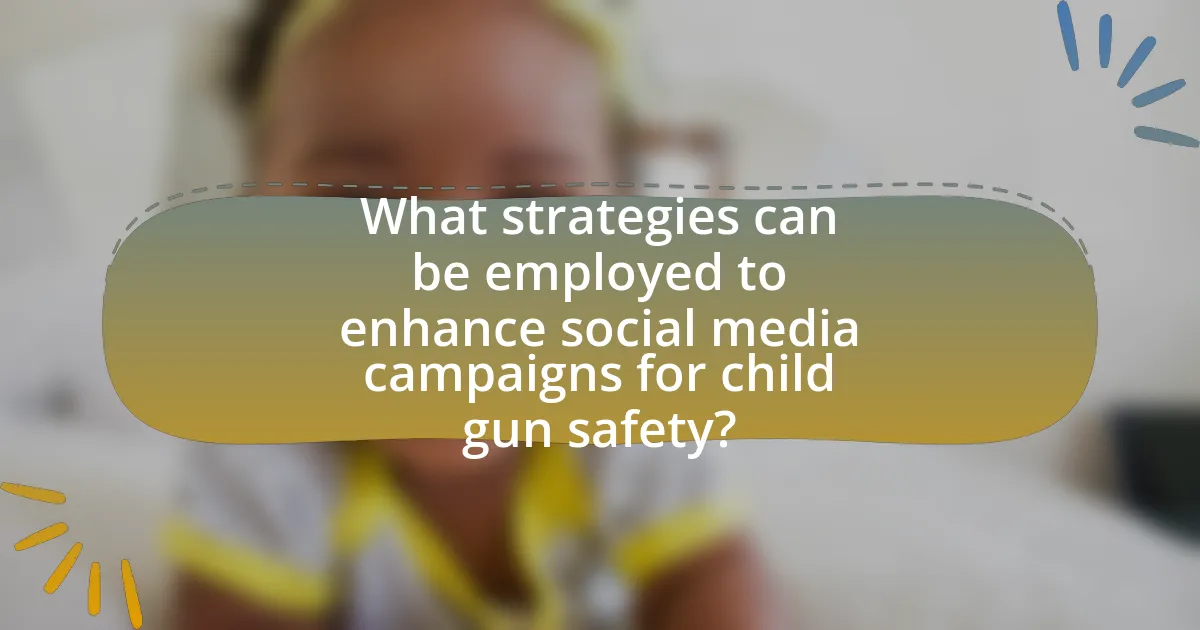
What strategies can be employed to enhance social media campaigns for child gun safety?
To enhance social media campaigns for child gun safety, organizations should employ targeted messaging, engaging visuals, and partnerships with influencers. Targeted messaging ensures that the content resonates with specific demographics, such as parents and educators, increasing the likelihood of engagement. Engaging visuals, including infographics and videos, can effectively convey critical safety information, as studies show that visual content is more likely to be shared and remembered. Collaborating with influencers who advocate for child safety can amplify the campaign’s reach, leveraging their established trust within communities. According to a report by the Pew Research Center, 69% of adults use social media, making it a vital platform for disseminating important safety messages.
How can influencers contribute to child gun safety awareness on social media?
Influencers can significantly contribute to child gun safety awareness on social media by leveraging their platforms to educate their followers about safe gun practices and the importance of secure storage. By sharing informative content, such as statistics on child gun accidents—where, according to the Centers for Disease Control and Prevention, nearly 500 children die from gun-related incidents annually in the U.S.—influencers can raise awareness and promote preventive measures. Additionally, influencers can collaborate with organizations focused on gun safety, such as the National Shooting Sports Foundation, to disseminate resources and tips for parents on how to keep firearms out of children’s reach. This approach not only amplifies the message but also encourages community engagement and dialogue around the issue, fostering a culture of safety and responsibility.
What are the best practices for collaborating with influencers on this topic?
The best practices for collaborating with influencers on the topic of utilizing social media to spread awareness on child gun safety include selecting influencers who have a genuine interest in child safety and a relevant audience. Collaborating with influencers who have previously engaged in similar advocacy can enhance credibility and reach. Establishing clear communication about campaign goals, messaging, and expectations ensures alignment between the influencer and the organization. Providing influencers with accurate information and resources about child gun safety empowers them to share informed content. Additionally, leveraging analytics to track engagement and impact can help assess the effectiveness of the collaboration. Research indicates that campaigns involving trusted influencers can increase awareness and drive action, as seen in studies like the “Influencer Marketing Benchmark Report” by Influencer Marketing Hub, which highlights the effectiveness of influencer partnerships in raising awareness on social issues.
How can user-generated content be leveraged to promote child gun safety?
User-generated content can be leveraged to promote child gun safety by encouraging parents and communities to share personal stories, tips, and educational resources on social media platforms. This approach fosters a sense of community engagement and allows for the dissemination of real-life experiences that highlight the importance of gun safety practices. For instance, campaigns like #NotAnAccident have successfully utilized user-generated content to raise awareness about accidental shootings involving children, leading to increased discussions and sharing of safety measures among users. By amplifying these narratives, social media can effectively educate and inform a broader audience about the critical need for child gun safety.
What role do hashtags play in social media campaigns for child gun safety?
Hashtags play a crucial role in social media campaigns for child gun safety by enhancing visibility and engagement. They allow campaigns to categorize content, making it easier for users to find and participate in discussions related to child gun safety. For instance, campaigns that use specific hashtags can reach a broader audience, as users searching for those hashtags can discover relevant posts and resources. Research indicates that posts with hashtags receive 12.6% more engagement than those without, demonstrating their effectiveness in increasing awareness and participation in critical issues like child gun safety.
Which hashtags have proven effective in raising awareness about child gun safety?
Hashtags that have proven effective in raising awareness about child gun safety include #EndGunViolence, #GunSafety, and #SafeStorage. These hashtags have been utilized in campaigns and social media posts aimed at educating the public on the importance of securing firearms to prevent accidental shootings involving children. Research indicates that posts using these hashtags have garnered significant engagement, amplifying the message and reaching a broader audience, thereby enhancing awareness and advocacy for child gun safety initiatives.
How can the strategic use of hashtags increase engagement on social media posts?
The strategic use of hashtags can significantly increase engagement on social media posts by enhancing visibility and facilitating audience targeting. Hashtags categorize content, making it discoverable to users interested in specific topics; for instance, using hashtags like #ChildGunSafety can connect posts to a broader conversation about child safety and gun control. Research indicates that posts with at least one hashtag receive 12.6% more engagement than those without, demonstrating the effectiveness of this strategy in reaching and engaging audiences.
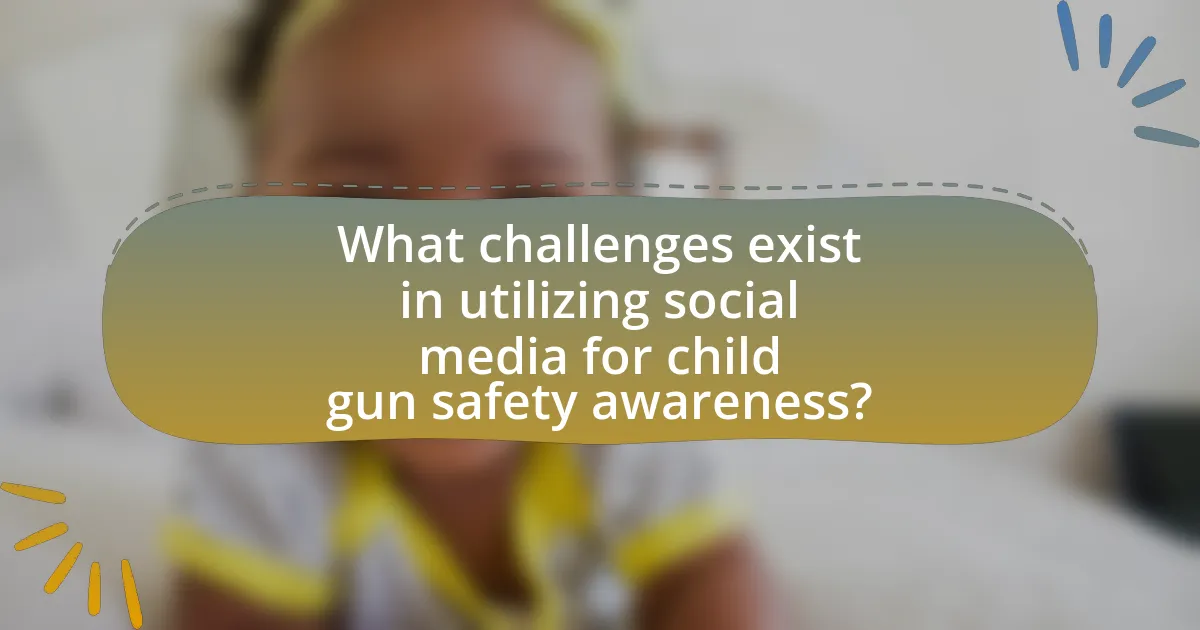
What challenges exist in utilizing social media for child gun safety awareness?
Utilizing social media for child gun safety awareness faces several challenges, including misinformation, audience engagement, and platform limitations. Misinformation can spread rapidly on social media, leading to confusion about gun safety practices; for instance, incorrect statistics or unsafe practices may be shared widely, undermining the intended message. Engaging the target audience, particularly parents and guardians, can be difficult due to the overwhelming amount of content on social media platforms, which can dilute the impact of safety campaigns. Additionally, platform limitations, such as algorithm biases and content moderation policies, can restrict the visibility of important safety messages, making it harder for organizations to reach their intended audience effectively.
How can misinformation be addressed in social media campaigns about child gun safety?
Misinformation in social media campaigns about child gun safety can be addressed by implementing fact-checking mechanisms and promoting evidence-based content. Fact-checking organizations, such as Snopes and FactCheck.org, can be engaged to verify claims made in posts, ensuring that only accurate information is disseminated. Additionally, campaigns should utilize clear, concise messaging that is backed by credible sources, such as the Centers for Disease Control and Prevention (CDC) and the American Academy of Pediatrics, which provide statistics and guidelines on child gun safety. By actively correcting false narratives and providing reliable resources, social media campaigns can effectively combat misinformation and enhance public understanding of child gun safety.
What strategies can be implemented to counteract misinformation effectively?
To counteract misinformation effectively, implementing fact-checking initiatives is essential. Fact-checking organizations, such as Snopes and FactCheck.org, verify claims and provide accurate information, which helps to debunk false narratives. Additionally, promoting media literacy among the public enables individuals to critically evaluate sources and discern credible information from misinformation. Research indicates that media literacy programs can significantly improve people’s ability to identify false information (Mihailidis & Viotty, 2017, “Media Literacy in a Post-Truth World,” Journal of Media Literacy Education). Furthermore, leveraging social media platforms to disseminate accurate information quickly can mitigate the spread of misinformation, as timely responses can correct false claims before they gain traction.
How can organizations ensure their messaging is clear and accurate?
Organizations can ensure their messaging is clear and accurate by employing straightforward language, consistent terminology, and thorough fact-checking. Utilizing plain language minimizes misunderstandings, while consistent terminology reinforces clarity across various platforms. Additionally, organizations should implement a rigorous fact-checking process to verify the accuracy of information before dissemination. Research indicates that clear messaging significantly enhances audience comprehension and retention, as evidenced by a study published in the Journal of Communication, which found that audiences are 70% more likely to understand key messages when presented in simple terms.
What are the potential risks of discussing child gun safety on social media?
Discussing child gun safety on social media poses several potential risks, including the spread of misinformation, increased anxiety among parents, and the potential for negative backlash from various communities. Misinformation can arise when users share unverified or inaccurate information about gun safety practices, which may lead to unsafe behaviors. Additionally, discussions can heighten anxiety among parents concerned about their children’s safety, potentially resulting in overreactions or unnecessary fear. Furthermore, public discourse on sensitive topics like gun safety can attract criticism or hostility from individuals or groups with opposing views, which may discourage open dialogue and hinder constructive conversations about child safety.
How can organizations protect themselves from backlash or negative responses?
Organizations can protect themselves from backlash or negative responses by implementing proactive communication strategies and engaging with their audience transparently. By actively monitoring social media channels and addressing concerns promptly, organizations can mitigate potential issues before they escalate. For instance, a study by the Pew Research Center found that 64% of social media users expect brands to respond to their inquiries within an hour, highlighting the importance of timely engagement. Additionally, organizations should establish clear guidelines for content that align with their values and mission, ensuring that messaging resonates positively with their audience. This approach not only fosters trust but also reduces the likelihood of misinterpretation or backlash.
What measures can be taken to create a safe online environment for discussions on child gun safety?
To create a safe online environment for discussions on child gun safety, implementing strict moderation policies is essential. These policies should include the use of trained moderators to monitor conversations, ensuring that harmful or inappropriate content is swiftly removed. Additionally, platforms can employ automated tools to detect and flag potentially dangerous discussions related to child gun safety. Research indicates that moderated online communities experience 50% fewer instances of harmful interactions, which underscores the effectiveness of these measures. Furthermore, establishing clear guidelines for acceptable behavior and providing educational resources can empower users to engage in constructive dialogue while prioritizing child safety.
What are some practical tips for creating effective social media content on child gun safety?
To create effective social media content on child gun safety, focus on clear messaging, engaging visuals, and actionable tips. Clear messaging ensures that the information is easily understood; for instance, using straightforward language to explain the importance of safe storage practices can resonate with parents. Engaging visuals, such as infographics or videos demonstrating safe handling techniques, can capture attention and enhance retention of the message. Actionable tips, like reminders to secure firearms in locked cabinets and to educate children about the dangers of guns, provide practical steps that parents can implement. Research indicates that visual content is 40 times more likely to be shared on social media, making it a powerful tool for spreading awareness effectively.
How can visuals enhance the impact of social media posts on child gun safety?
Visuals can significantly enhance the impact of social media posts on child gun safety by increasing engagement and retention of information. Research indicates that posts with images or videos are 94% more likely to be viewed than those without, making visuals a powerful tool for conveying critical safety messages. For instance, infographics that illustrate safe storage practices or statistics about child gun accidents can effectively communicate risks and preventive measures, leading to greater awareness and behavioral change among parents and caregivers.
What types of calls to action are most effective in encouraging engagement on this topic?
Direct and specific calls to action, such as “Share your story,” “Join the conversation,” and “Take the pledge,” are most effective in encouraging engagement on the topic of utilizing social media to spread awareness on child gun safety. These types of calls to action prompt individuals to participate actively, fostering a sense of community and shared responsibility. Research indicates that engagement increases when users feel personally connected to the message, as seen in campaigns that encourage sharing personal experiences related to child safety and gun ownership. For instance, a study by the Pew Research Center found that social media users are more likely to engage with content that invites them to contribute their own narratives or commitments, thereby amplifying the message’s reach and impact.
